2011-01-14 (NASA Press Release)
NASA Satellites Find High-Energy Surprises in 'Constant' Crab Nebula
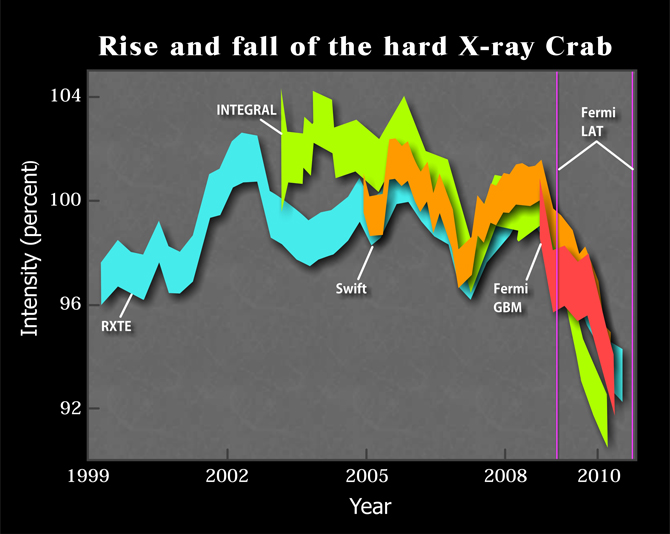
X-ray data from NASA's Fermi, RXTE, and Swift satellites and the European Space Agency's
International Gamma-Ray Astrophysics Laboratory (INTEGRAL) confirm that the Crab Nebula's
output has declined about 7 percent in two years at energies from 15,000 to 50,000 electron
volts. They also show that the Crab has brightened or faded by as much as 3.5 percent a
year since 1999. Fermi's Large Area Telescope (LAT) has detected powerful gamma-ray flares
(magenta lines) as well.
Image credit: NASA's Goddard Space Flight Center
|
The combined data from several NASA satellites has astonished astronomers by revealing
unexpected changes in X-ray emission from the Crab Nebula, once thought to be the steadiest
high-energy source in the sky.
"For 40 years, most astronomers regarded the Crab as a standard candle," said Colleen Wilson-Hodge,
an astrophysicist at NASA's Marshall Space Flight Center in Huntsville, Ala., who presented the
findings today at the American Astronomical Society meeting in Seattle. "Now, for the first time,
we're clearly seeing how much our candle flickers."
Links:
 NASA press release
NASA press release
 ESA press release
ESA press release
Original paper:
The Astrophysical Journal Letters, Volume 727, Number 2, pp.40-45 (2011)
Others:
Sky and Telescope
|
|
2011-01-10 (MPE Press Release)
Space telescope catches antimatter from terrestrial thunderstorms
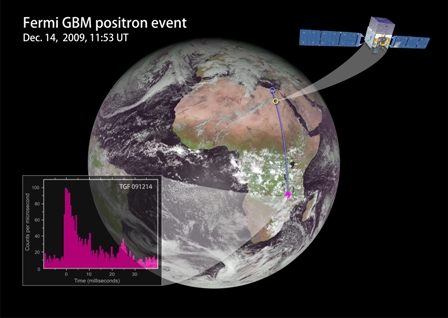
While Fermi flew over Egypt, the GBM intercepted a particle beam from a terrestrial gamma-ray flash
(TGF) that occurred in a thunderstorm below its horizon.
Credit: NASA/Goddard Space Flight Center
|
Normally astronomers look deep into space, but in the latest finding from the NASA Fermi
Gamma-ray Space Telescope presented on Monday, Jan. 10, during a news briefing at the American
Astronomical Society meeting, they detected an antimatter signal from Earth. Created in energetic
processes above thunderstorms, when such an antimatter beam strikes the spacecraft, it actually
becomes a source of the gamma-ray light it was designed to observe. Scientists at the Max Planck
Institute for Extraterrestrial Physics (MPE) were responsible for the development of the detectors
and the power supplies of the Fermi Gamma-ray Burst Monitor (GBM), which led to this discovery,
and contributed to the calibration and data analysis for this particular result.
[
 more ] more ]
|
|
2009-11-05
Testing Einstein's Special Relativity with Gamma-Ray Burst Photons
|
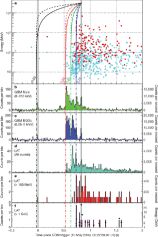
Photon arrival times
(for details see Nature paper)
Image: Nature
|
Einstein's special relativity postulates that observers see the same speed of light in
vacuum, independent of photon-energy. At a fundamental scale (the Planck scale),
quantum effects are expected to affect the nature of space'time, and Lorentz invariance
might become violated. MPE scientists have been involved in a key test of such violation,
namely the possible variation of photon speed with energy over cosmological light-travel times.
This became possible by the detection of emission from keV up to 31 GeV energies with the
Fermi satellite's instruments (GBM, LAT) from the distant and short gamma-ray burst GRB090510.
No violation of Lorentz invariance was found to 1 part in 1017, placing the tightest limits so far
and eliminating some quantum-gravity theories.
(Abdo et al., Nature 462, Oct 2009)
Links:
 Stanford University News
Stanford University News
 Nature original publication
Nature original publication
|
|
2009-02-19
NASA'S FERMI TELESCOPE SEES MOST EXTREME GAMMA-RAY BLAST YET
|
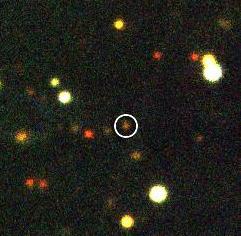
31.7 hours after GRB 080916C exploded, the MPE Gamma-Ray Burst
Optical/Near-Infrared Detector (GROND), began acquiring
images of the blast's fading afterglow (circled).
Image: MPE / GROND
|
The first gamma-ray burst to be seen with substantial GeV emission from
NASA's Fermi Gamma-ray Space Telescope is one for the record books. The
blast had the greatest total energy, the fastest motions and the
highest-energy initial emissions ever seen.
[
 more ] more ]
|
|
2008-08-26
GLAST renamed Fermi
|
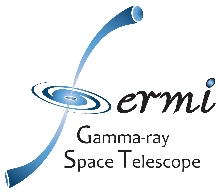
Fermi logo
Credit: NASA/Sonoma State University/Aurore Simonnet
|
The Gamma-ray Large Space Telescope GLAST was officially renamed to
Fermi Gamma-ray Space telescope.
The new name honors Prof. Enrico Fermi (1901 - 1954), a pioneer
in high-energy physics.
NASA press release
Accordingly, the former GLAST Burst Monitor GBM is now called
"Fermi Gamma-ray Burst Monitor" or "Fermi-GBM".
|
|
2008-08-26
GLAST First Light
GLAST Burst Monitor detects 31 Gamma Bursts
|
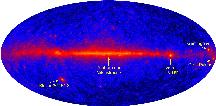
First all-sky image taken by the Large Area Telescope of the Fermi
Gamma-ray Space Telescope.
Image Credit:
NASA/DOE/International LAT Team
|
GLAST, the Gamma-Ray Large Area Space Telescope, has begun its mission of
exploring the universe in high-energy gamma rays. The spacecraft and its
revolutionary instruments passed their orbital checkout with flying colors.
GBM, the GLAST Burst Monitor, spotted 31 gamma-ray bursts in its first
month of operations.
NASA announced today that GLAST has been renamed the Fermi Gamma-ray Space
Telescope.
|
|
2008-08-12
First GBM GCN notice issued
|
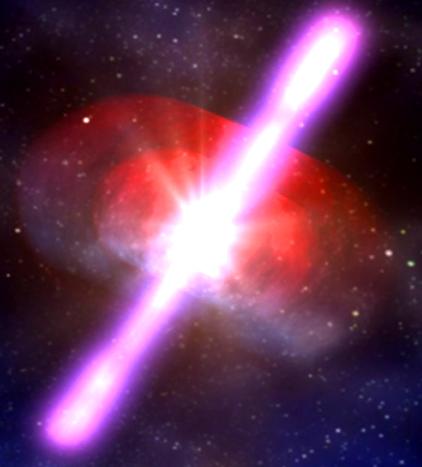
Gamma-Ray burst
Illustration: NASA/D.Berry
|
The Gamma-ray burst of August 10 2008 (GRB080810) was the first GRB
to be announced by GBM using the GCN (Gamma ray bursts Coordinates
Network) system.
The delay of two days is caused by the onground analysis of the burst
to derive a more accurate position, lightcurve, spectrum and fluence.
This time span will be reduced in the coming weeks
(see
GCN 8096).
GCN 8100
Gamma ray bursts Coordinates Network
|
|
2008-07-29
First gamma-ray bursts detected by GBM
|

Powerful burst from July 23
Image: NASA
|
While only on orbit for 40 days and still in the process of a two-month
checkout, GBM has already detected 12 powerful gamma-ray bursts, an
encouraging harbinger of good things to come for this mission.
MSFC News Release 2008-07-28
NASA / GLAST News 2008-07-28
|
|
2008-06-26
GBM successfully turned on
|

GBM detectors
Image: Ben Cooper
|
On Thursday, June 26 at 0:45 UT all GBM detectors were turned on.
All systems are working normally.
After some more days with thorough check-out, GBM will be operational.
A nice
Article in physorg.com.
NASA / MSFC News Release 2008-06-27
|
|
2008-06-11
GLAST successfully launched
|
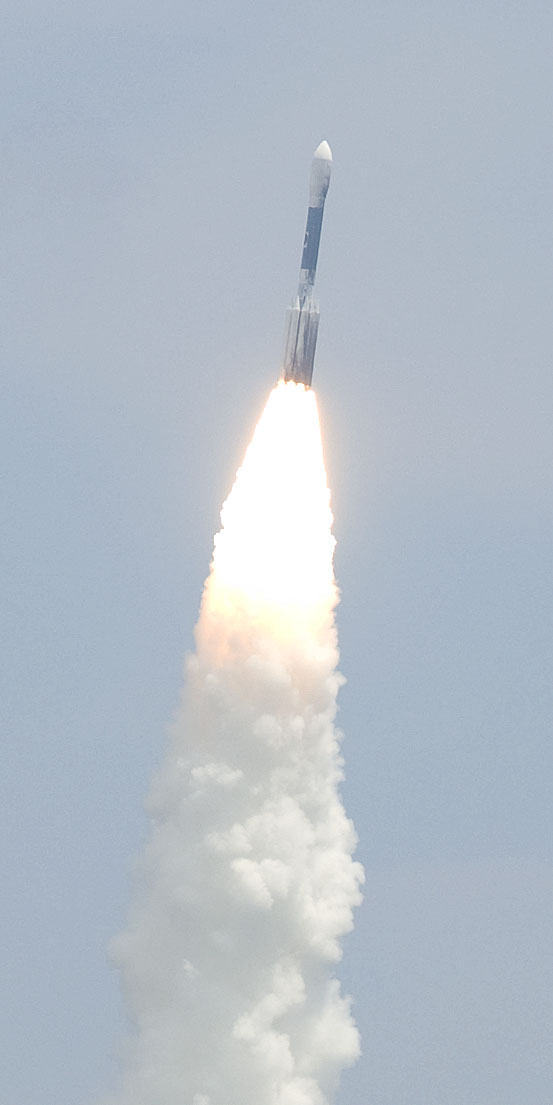
Launch!
Photo: Michael Briggs
|
Finally, GLAST is in orbit.
A
HD video of the launch is available on the GLAST web page.
Very good pictures from the launch on
Ben Cooper's web site
|
|
2008-05-14
Launch in June decided
|

Technicians conduct black light inspection of the GLAST spacecraft during
final cleaning.
|
After some worrysome days (weeks) with rumors that the launch may slip as
much as August/September, a launch date "no earlier than June 3rd" was set.
This launch date is closely coupled to the Space Shuttle launch on May 31.
If this launch slips, the GLAST launch will slip accordingly.
The launch preparations on the spacecraft, which had been halted
continue now and the spacecraft has been fueled. It will be moved to the
launch pad soon.
|
|
2008-03-24
Final Pumpdown of the GBM NaI Detectors Successfully Completed
|
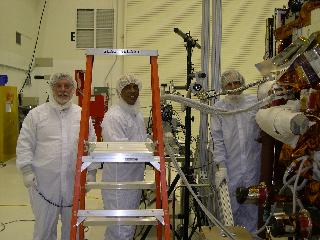
The pumpdown team at work
|
The final pumpdown of the NaI detectors of the GBM detector system
was successfully completed on Mach 24, 2008. This last pumpdown before
launch is a precautionary measure to prevent a build-up of internal
pressure in the NaI detectors that could damage the thin Be window in
vacuum.
|
|
2008-03-04
GLAST arrives at the Kennedy Space Center
|
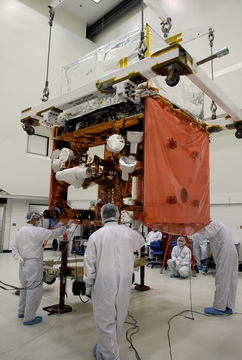
GLAST arrival.
Good view of the GBM detectors!
Image: NASA
|
NASA's Gamma-ray Large Area Space Telescope, or GLAST, arrived March 04,
2008 at the Astrotech payload processing facility near the Kennedy Space
Center to begin final preparations for launch.
More details can be found at the
GLAST pages at NASA.
A lot of pictures taken during unpacking are available at the
Media Gallery of KSC.
|
|
2008-02-13
First stage of GLAST launcher arrives at KSC
|
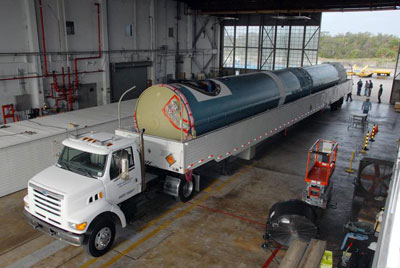
GLAST Delta II first stage arrives
Credit: NASA
|
The United Launch Alliance Delta II rocket's first stage was
revealed after the cover was removed from the truck that delivered it.
Hopefully this rocket will deliver GLAST into its orbit in May.
[more].
|
|
2008-01-24
GLAST in NASA's Headline News
|

Gamma-ray sky map with GRB
|
Gamma-ray bursts (GRBs) and GLAST are featured in NASA's
Headline News.
|
|
2008-01-10
"Aliens at NRL!"
|
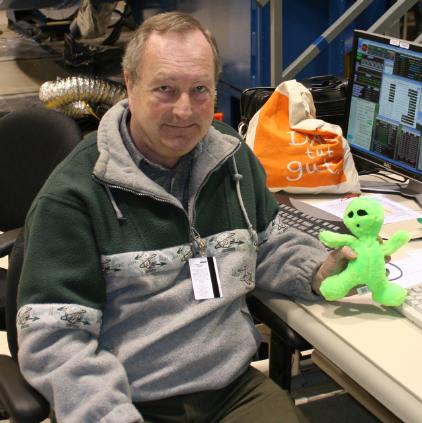
One of the two aliens with another alien.
|
The MPI for extraterrestrial Physics
supports the final GLAST thermal-vacuum test at NRL. Two members of
the GBM team from Germany help with the 24/7 tests.
The official identification is "GBM Foreign Nationals" or
"Aliens"!
|
|
2007-12-06
GLAST arrived savely at NRL
|

truck
|
On November 28 the truck carrying GLAST arrived savely at NRL
(see the
press release).
The start of the Thermal Vacuum test is now scheduled for
December 28, 2007.
The relocation and the prospects for launch are described in more detail
in a relatively critical article in Aviation Week (Dec. 4, 2007):
"GLAST Diverts To NRL For Tests".
|
|
2007-10-09
GLAST Thermal-Vacuum-Test
|
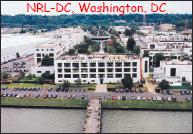
NRL
Washington, DC, USA
|
The decision has been made to do the TVac test of GLAST at the Naval
Research Laboratory (NRL; in Washington DC). The TV chamber at General
Dynamics is occupied by "more important" satellites at the moment. Start
of the tests is scheduled for mid December.
A new launch date has been set: May 28, 2008!
|
|
2007-10-05
GLAST Vibration-Test
|

GLAST at the
General Dynamics
"Factory of the Future"
|
End of September and beginning of October, the GLAST vibration tests
have been conducted successfuly.
|
|
2007-06-28
GLAST EMI/EMC-Test
|

General Dynamics
"Factory of the Future"
|
During May and June 2007, the GLAST EMI/EMC
(Electromagnetic Interference / Electromagnetic Compatibility) Tests have
been performed at the General Dynamics facility in Phoenix, AZ. GBM team
members of MPE have supported this activity.
|
|